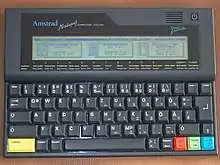Amstrad NC100
The Amstrad NC100 Notepad was an A4-size, portable Z80-based[2] computer, released by Amstrad in 1992. It featured 64 KB of RAM, the Protext word processor, various organiser-like facilities (diary, address book and time manager), a simple calculator, and a version of the BBC BASIC interpreter.[3]
 A German Amstrad NC100 | |
| Developer | Amstrad |
|---|---|
| Type | Portable computers |
| Release date | 1992 |
| CPU | Z80 at 4 Mhz |
| Memory | 64 KB RAM[1] |
| Storage | 256 KB ROM[1] |
| Display | LCD 80 columns by 8 rows |
| Connectivity | RS-232 serial port, parallel port, PC card socket (Allowed expanding memory up to 1 MB) |
| Power | four standard AA cell batteries |
Its screen was 80 character columns by eight rows, and not backlit, but this let the NC100 run for up to 20 hours on four standard AA cell batteries. There was an RS-232 serial port, a parallel port for connecting a printer, and a PC card socket, by means of which the computer's memory could be expanded up to 1 MB.
Design
The NC100 was designed to be a portable computer which was simple to use. That was the brief given by Sir Alan Sugar (then chairman of Amstrad) to his design staff. The NC100 project was internally referred to as Alan's "Baby" and Alan Sugar himself tested the machine for usability during the design phase. The specifications for the computer were not considered important - as long as it could serve its purpose.
The user-friendly features of the NC100 come from the software which is included in the firmware. Protext and the other applications were designed with a computer novice in mind - although experienced users can find and use a large array of more complicated features.[4]
Alan Sugar actually wrote the first chapter of the NC100's user manual in order to show that even he could use it.[5]
The design also included terminal emulation and XMODEM file transfer software which enabled the NC100 to communicate through dial-up analogue modems. UK tech journalist Sue Schofield used one to upload a review of the NC100 directly into the online filing computer of the Independent newspaper in 1993. The review was written on the machine, and transferred from it over a battery-powered 300 baud modem.
Upgrades

An upgraded variant, the NC200 Notebook, appeared in late 1993. This came in a clamshell-type form factor with a flip-up screen featuring a backlit 80 x 16 character text screen and double the vertical pixel resolution as the NC100. The NC200 had a 720 KB 3.5" floppy disk drive able to read/write MS-DOS-formatted disks, 128 KB RAM, and some extra software - notably three Tetris-like games and a capable spreadsheet with rudimentary database capability. However, these changes required much greater power use, requiring 5 C cell batteries. The disk drive could only be used at near full-charge, which meant that it could only be used a few hours after putting in new batteries. The laptop could function for considerably longer without using the disk drive. The backlight can be manually toggled off to save power by pressing the Control and Caps Lock keys at the same time.
An intermediate version, the NC150 Notepad, was also produced, but was available only in Italy and France; its case had the same design as the NC100, but it included the games later seen on the NC200.
Variants
Both the NC100 and NC200 were licensed to a company called NTS Computer Systems in British Columbia and marketed as the Dreamwriter 100 and Dreamwriter 200, respectively. These were the same computers apart from having only Protext and Personal information manager apps installed (no BBC Basic, no games, and no spreadsheet). The Dreamwriter 200 had a 1.44 MB floppy disk drive, an upgrade from the NC200's 720 KB drive. Its user guide cautions against using the low-density floppy disks.
The cases were off-white in color with blue and green stripes separating the screen from the keyboard. There were blue and green colored keys also. The Dreamwriters were retailed by Radio Shack in the U.S. for a short time in the mid-1990s.
References
- Page 247, The Amstrad Notepad Advanced User Guide, By Robin Nixon, 1993, ISBN 1850585156, ISBN 9781850585152, ...(rather than the 256K ROM and 64K RAM of the NC100...
- Ian R. Sinclair. (2000). Practical electronics handbook. Oxford: Newnes. p. 204. ISBN 978-0-7506-4585-0.
- How to Program the Amstrad NC100 Notepad, By Patrick Hall, Sigma Press, 1993, ISBN 1850585113, ISBN 9781850585114
- "Archived copy". Archived from the original on 2011-07-27. Retrieved 2010-01-07.
{{cite web}}: CS1 maint: archived copy as title (link) - Sir Alan Sugar. (1992). Amstrad Notepad Computer Manual. Brentwood: Amstrad. p. 1.